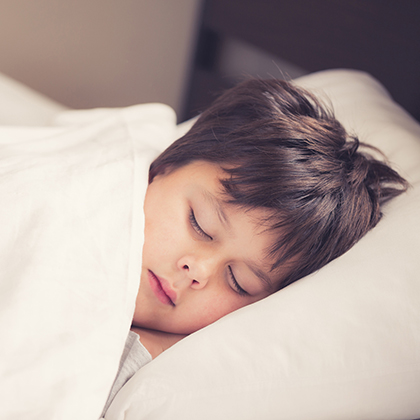
Like adults, most children and young people have worries and fears at some time or other, and it’s normal for them to feel anxious at certain points in their lives – when they’re starting a new school, for instance, or during exams. Once these stressful situations are over, however, most children feel better and calmer.
But when a child feels worried or anxious most or all of the time, it can affect their mood and behaviour, and may even have a negative impact on their school, home and social life.
This may be more common than most people think. According to the NHS, anxiety disorders are estimated to affect up to 19 per cent of all children and adolescents, including up to five per cent of children under the age of 12 (i).
There are lots of reasons why some children and not others are susceptible to anxiety. Some are simply born with a more nervous temperament and are less capable of coping with stress than others – something they may have inherited from one or both parents – or they may learn anxious behaviours if they’re frequently around adults who have a problem with anxiety.
The NHS claims children with attention deficit hyperactivity disorder (ADHD) and autistic spectrum disorders are also more likely to have anxiety issues (ii). Or some children may become anxious because they’re exposed to stressful events more than others, such as having a serious illness, abuse, neglect, bereavement and bullying at school, or having parents who argue or fight a lot (or parents who are separating or divorcing).
Types of anxiety
There are several different types of anxiety that are common in children and teenagers:
Separation anxiety
This is thought to be the most common anxiety disorder in children under 12 and usually starts to develop when a child is around six months of age (i). It’s when children become very worried and upset when they’re separated from their parent or carer. They may become very anxious if they have to spend any time away from home, which can make things like starting school very difficult for them. Another thing children with separation anxiety can experience is the worry that something bad will happen to them or their parent/carer if they spend any time apart.
Social anxiety
Mostly affecting older children who have gone through puberty, social anxiety is more than simple shyness, it’s a fear of social situations. Children with social anxiety may become very anxious when they’re with people they’re not used to spending time with and when they’re away from their home. Even everyday activities such as speaking on the phone, seeing friends or going shopping can cause extreme emotions in a socially anxious child. They may also worry about being humiliated if they do or say anything when in a social situation.
School-based anxiety
Going to school, making friends, performing in class and the fear of being bullied can cause anxiety in some children too. They may not talk to their parents or caregivers about what’s worrying them, but they may try to get out of going to school on a regular basis by complaining they feel ill. Another sign to look out for is crying or complaints of tiredness on school-day mornings.
Phobias
If a child has a specific phobia it can cause high levels of anxiety, especially if the thing they’re afraid of is something they encounter regularly. Being afraid of scary things is a normal part of growing up, but when a child has a severe, overwhelming, irrational fear of something – thunder and lightning, for instance, or spiders – it can have a significant impact on their day-to-day life.
Non-specific anxiety
Some children affected by anxiety can develop generalised anxiety disorder (GAD) when they reach their teenage years. GAD is when you have feelings of anxiety most or all of the time about lots of different things, rather than one thing in particular.
How to spot the signs
Children with anxiety may feel constantly nervous, panicky or frightened. But there are many other signs, some of which aren’t that obvious. Some of the things to look out for include the following:
-
Lack of concentration
-
Poor appetite
-
Irritability and tantrums
-
Frequent health complaints (upset stomach or headache, for instance)
-
Frequent crying
-
Shyness and clinging to parents or carers when around others
-
Inability to mix or play with other children
-
Constant fidgeting, tenseness
-
Using the toilet frequently
Children who are anxious may also have one or more sleep difficulties. They may not find it easy to get to sleep or stay asleep, for example, or they may wake frequently because they’re having nightmares. Bedtime can also be a challenging time for some children, especially if they have a fear of the dark or they’re afraid of monsters.
Meanwhile, according to experts from the Millpond Sleep Clinic older school-aged children who have sleep difficulties can be prone to perfectionism and may be academic high achievers. Sleep can become an issue for them if they start to develop anxiety over how not sleeping will affect their performance at school, which stops them from falling asleep and can even lead to negative thoughts or fears about sleep (iii).
How parents can help
If you suspect your child is having a problem with anxiety, there’s lots you can do to help them stay calm and more reassured:
Talk about it
One of the most important things a parent or carer can do for a child who is experiencing anxiety is to help them get things out in the open. Try to make time to talk to your child, and always take their worries seriously, no matter how small or irrelevant they may seem to you. Tell them that having worries is a normal part of life, and that everyone feels a little bit anxious from time to time.
Distract them
If you notice your child is feeling anxious, try getting them to do something that could take their mind off their worries. You could, for instance, help them visualise being in a safe, happy place where they feel comfortable. This could be a place where they had a happy family holiday or a grandparent’s or friend’s house. Once you’ve established where their happy place is, describe it to them and encourage them to imagine being there. Other distraction ideas include getting them to do some drawing or colouring, to listen to some music, to work through puzzle books or to play with friends, family or pets.
Teach them calm breathing
If your child is feeling anxious, there’s a good chance they will be taking shorter and faster breaths, which can make them feel even more tense. Here’s a method you can teach your child breathe more slowly and deeply, as suggested by Anxiety Canada (iv):
-
Take a slow breath in through the nose (about four seconds)
-
Hold for one or two seconds
-
Exhale slowly through the mouth (about four seconds)
-
Wait a couple of seconds before taking another breath
-
Repeat at least five to 10 times
For younger children, try this with the bubble blowing technique – all you need is a bubble blowing toy (a container with soapy water and a wand), which you can buy from most toy shops. Use the above steps, but as they’re exhaling your child will blow a bubble. This can make learning the technique more fun.
Personalise their worry
Encourage your child to come up with a code name for their anxiety, as it may make it easier for them to discuss it with you when they feel anxious. Also suggest that they draw a picture of their anxiety – giving it a name as well as a visual representation may help your child to manage it more easily or to distance themselves from it.
Make a worry box
Help your child to make a special box where they can put the things they feel anxious about. Make the box as fun as possible by decorating it with them, then get them to write the things they’re worried about on a piece of paper and then post the paper in the box. After a week or two take the worries out again – if your child feels differently about a specific worry by this time, suggest they tear the piece of paper up.
Set a good example
Children often learn anxious behaviours from those around them, so if your child has a tendency to worry, try to be particularly careful about any negative emotions you display that they could pick up on.
Encourage healthy habits
Having a balanced diet and being physically active on a regular basis can help children cope with stress and worries more effectively, so encourage them to maintain a healthy lifestyle.
Schedule ‘worry’ time
It may be unrealistic to expect children to give up worrying altogether, so help them focus on their anxieties less frequently by organising regular ‘worry’ time. This could be a set 10 minutes every day, for example, when you both talk about everything that’s been worrying them and think about how to resolve their issues. However, try not to schedule ‘worry’ time too close to bedtime, as it may stop a child sleeping well.
Meanwhile if your child finds bedtime stressful, establishing a calming night-time routine could be helpful. Find out more in our guide to children and sleep.
Anxiety treatments for children
If your child is anxious all the time and things aren’t getting any better (or they’re getting worse), it may be time to take them to see their GP for some professional help.
According to the NHS, long-term anxiety can interfere with many aspects of a child’s life, including their school life, their family life, their social life and their personal development (i). And if it’s left to persist into their teenage years and early adulthood, they may be more likely to develop clinical depression.
Seeing their GP could get them the help they need. You could talk to their GP with or without your child present, or your child may decide to have an appointment without you. And if your GP diagnoses your child with an anxiety disorder, they may refer them to a specialist trained to help children and young people at a local child and adolescent mental health service (CAMHS), such as a psychologist, psychiatrist or psychotherapist.
If your GP or CAMHS specialist decides your child needs treatment for an anxiety disorder, the type of help available will depend on the cause of their problem. The main treatments include the following:
Counselling
Talking to a professional such as a psychotherapist, psychologist or a trained youth counsellor may help a child figure out what’s causing their anxiety and what steps they can take to manage it. Your child may also open up more to someone they don’t know.
Cognitive behavioural therapy
Like counselling, CBT is a talking therapy, but the difference is CBT aims to help you manage your problems by changing the way you think and behave. According to the NHS, CBT has been proven to help with mild to moderate anxiety, and is often recommended to young people with anxiety disorders – though it’s not currently clear whether it’s effective for younger children under the age of six (i). Up to 20 sessions may be required for the treatment to be effective.
Anxiety medication
This is usually only offered if a child has severe anxiety or if they’ve tried talking therapies and their anxiety hasn’t improved. Only prescribed by specialist doctors, anxiety medicines include antidepressants called selective serotonin reuptake inhibitors (SSRIs). These often take up to four weeks to start working, so you probably won’t notice a difference in your child straight away.
For more detailed information about the different types of anxiety in children, including the ways it can be treated, take a look at the Mental Health Foundation’s booklet, The Anxious Child.
Natural anxiety relief
If you’re looking for natural ways of managing anxiety, there are some products that may help support an anxious child, including the following:
Live bacteria
A scientific review suggests taking a live bacteria supplement (or probiotic) may help reduce anxiety in adults, with the bacteria Lactobacillus rhamnosus the most effective, say researchers writing in the medical journal PLoS One (v). There’s currently a lack of studies into childhood anxiety and live bacteria, but you can add more live bacteria to your child’s diet by giving them natural live yoghurt.
Multivitamin and mineral supplement
There are certain vitamins and minerals that could help your child feel more relaxed, which you can find in a good-quality multivitamin and mineral supplement formulated for children.
One of these is magnesium, which has been found to help adults manage stress-related sleep problems (vi). And while there aren’t any studies that have investigated the role of magnesium supplements in children with anxiety, there is some evidence that magnesium levels can be depleted in adults who are stressed (vii).
To make sure your child has a magnesium-rich diet, give them plenty of fruit, green leafy vegetables, peas, broccoli, green beans and whole grains such as brown rice and oats.
Several of the B vitamins – which you can also find in a multivitamin and mineral supplement formulated for children – are also thought to help with anxiety in adults (viii), while vitamin B6 is needed by the body for the production of mood-regulating chemicals such as serotonin and norepinephrine.
You can help give your child the B vitamins they need by making sure they get plenty of whole grains, fortified foods (such as breakfast cereals), eggs, milk, green leafy vegetables and fruit in their diet.
Lavender oil
Lavender essential oil is considered by some an effective natural way to treat the signs of anxiety in adults (ix). Try using the smell of lavender to soothe an anxious child by adding a drop of essential oil to their bath water or by heating some in a diffuser whenever they are showing signs of worry.
Lavender oil may not be suitable for all children, however, with a study published in the Journal of Pediatric Endocrinology and Metabolism (ix) suggesting It may disrupt hormone levels in young boys who haven’t reached puberty. Parents of children who have asthma should also take care when diffusing lavender or any other aromatherapy oil.
References:
-
Available online: https://www.nhsinform.scot/illnesses-and-conditions/mental-health/anxiety-disorders-in-children
-
Available online: https://www.nhs.uk/conditions/anxiety-disorders-in-children
-
Available online: https://millpondsleepclinic.com/category/anxiety-sleep-problems-in-children-causes
-
Available online: https://www.anxietycanada.com/sites/default/files/calm_breathing.pdf
-
Reiss. D.J., et al. The anxiolytic effect of probiotics: A systematic review and meta-analysis of the clinical and preclinical literature. PLoS One. 2018. 13(6): e0199041. Available online: https://www.ncbi.nlm.nih.gov/pmc/articles/PMC6010276
-
Held. K., Antonijevic. I.A., Kunzel. H., et al. Oral MG(2+) supplementation reverses age-related neuroendocrine and sleep EEG changes in humans. Pharmacopsychiatry. 2002. 35:135-143. Available online: https://www.ncbi.nlm.nih.gov/pubmed/12163983
-
Grases. G., Perez-Castello. J.A., et al. Anxiety and stress among science students. Study of calcium and magnesium alterations. Magnes Res. 2006 Jun. 19(2):102-6. Available online: https://www.ncbi.nlm.nih.gov/pubmed/16955721
-
Lewis. J.E., et al. The effect of methylated vitamin B complex on depressive and anxiety symptoms and quality of life in adults with depression. ISRN Psychiatry. 2013 Jan 21. 2013:621453. Available online: https://www.ncbi.nlm.nih.gov/pubmed/23738221
-
Woelk. H., Schlafke AJ., A multi-center, double-blind, randomised study of the Lavender oil preparation Silexan in comparison to Lorazepam for generalized anxiety disorder. Phytomedicine. 2010 Feb;17(2):94-9. Available online: https://www.ncbi.nlm.nih.gov/pubmed/19962288
-
Diaz. A., et al. Prepubertal gynecomastia and chronic lavender exposure: report of three cases. J Pediatr Endocrinol Metab. 2016 Jan. 29(1):103-7. Available online: https://www.ncbi.nlm.nih.gov/pubmed/26353172
Related Posts
Disclaimer: The information presented by Nature's Best is for informational purposes only. It is based on scientific studies (human, animal, or in vitro), clinical experience, or traditional usage as cited in each article. The results reported may not necessarily occur in all individuals. Self-treatment is not recommended for life-threatening conditions that require medical treatment under a doctor's care. For many of the conditions discussed, treatment with prescription or over the counter medication is also available. Consult your doctor, practitioner, and/or pharmacist for any health problem and before using any supplements or before making any changes in prescribed medications.

Christine
Christine Morgan has been a freelance health and wellbeing journalist for almost 20 years, having written for numerous publications including the Daily Mirror, S Magazine, Top Sante, Healthy, Woman & Home, Zest, Allergy, Healthy Times and Pregnancy & Birth; she has also edited several titles such as Women’ Health, Shine’s Real Health & Beauty and All About Health.
View More



